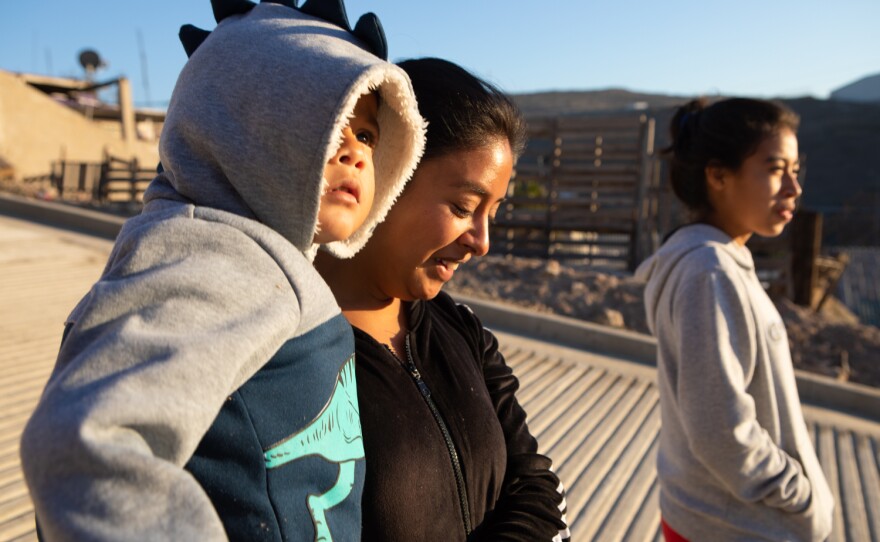Thousands of migrants with hopes for the U.S. are living in limbo in Tijuana as a legal battle over whether to end a pandemic-era policy that has restricted asylum access for nearly three years heads to the U.S. Supreme Court.
The high court’s involvement suggests answers to that question, and the possible end of the expulsion policy, are in sight, though still months away.
The Supreme Court will hear arguments in February, granting a request for intervention from mostly Republican-led states that want to stop the Biden administration from ending the Trump-era health policy, arguing its rollback would lead to an influx of migrants at the border and “inflict massive irreparable harms on the States.”
While the case plays out in the court, officials and humanitarians in Tijuana are watching as they continue to manage a city where thousands of migrants have been waiting, some for years, to act on their right to ask the U.S. for asylum protections.
“(Shelters) are at their maximum capacity due to this measure and the longer it takes for Title 42 to end, the lag will continue growing and the challenge will be greater whenever Title 42 truly ends,” said Enrique Lucero, director of migrant affairs for the city of Tijuana.
inewsource visited several migrant shelters in Tijuana in the weeks leading up to the planned rollback of Title 42. Many migrants had not heard the news that the policy’s end could be imminent, and it didn’t drive their decision to wait in Tijuana. But shelter leaders were already anticipating the impact.

At the Templo Embajadores de Jesús shelter in Tijuana, one of the larger shelters in the city, construction is underway to increase capacity, but it can’t come fast enough. In early December, migrants formed a line to unload cinder blocks from a truck and pass them towards an unfinished building at the top of a hill.]
Gustavo Banda Aceves, director of the shelter, said in early December that his shelter already reached capacity, but more migrants are coming.
“Hard times are coming for everybody,” Banda Aceves said.
Title 42 was first implemented by the Trump administration at the start of the COVID-19 pandemic to prevent spread of the virus in the U.S., but critics say the policy was more about preventing immigration.
Under the policy, immigration officials turn away migrants at ports of entry or expel them from within the U.S. back to Mexico or their country of origin. Immigration advocates say the policy has led to thousands of migrants waiting in border cities including Tijuana where they’ve endured attacks and exploitation.
Human Rights First, a nonpartisan organization promoting international human rights, has tracked more than 13,000 reports of violent attacks on migrants in Mexico affected by Title 42.

Death threats from criminals drove Reyes Garcia Hernandez and his partner to flee their home in the Mexican state of Michoacán for the United States. The threat of violence also kept them confined to the shelter they were staying at while in Tijuana waiting to ask for asylum in the U.S.
“Here in the city of Tijuana, regardless, we do not feel safe. That’s why we’ve decided not to leave the shelter.” Garcia Hernandez said. “Now we are waiting. We have the faith that being in the United States is something better than being here.”
After two months of living in the shelter, Garcia Hernandez and his partner were processed into the U.S. last month as exemptions to Title 42 under an agreement with U.S. immigration authorities and nonprofit organizations working with migrants. They’re now reunited with a family sponsor in the United States.
Under the current agreement, around 200 migrants in Tijuana per day are allowed into the U.S., according to Lucero.
Neither the Department of Homeland Security nor its border enforcement branch, Customs and Border Protection, responded to multiple requests for comment.

Between six- and eight-thousand migrants are currently on that list and living among about 30 shelters in Tijuana, Lucero said.
“Many migrants get desperate and then, they try to throw themselves at the wall, to cross the wall, turn themselves in or swim by Playas de Tijuana risking their lives,” Lucero said. “This long wait is very frustrating for them.”
Dozens of deaths have been documented in recent years in the San Diego region as migrants have fallen from the southern border wall, drowned in the water off the coast or trekked through the rural mountainous region along the border.
Still, some shelter directors worry about what’s to come after Title 42. The current exemption program, though insufficient compared to the need, gives a degree of access to migrants who come to Tijuana, they said.
“I’d like it to continue as it is at this moment, but (I’d like) for them to give out more numbers per week so that people can leave orderly,” Banda Aceves, director of the Embajadores de Jesus shelter, said.
Right now, migrants at that shelter typically wait a few months there before they are processed into the U.S. through the exemption program. The process makes the wait more bearable, Banda said.

But there are some migrants who have waited much longer than a few months. Mairani Rubio Padilla and her son, asylum-seekers fleeing extortion and violence in Michoacán, Mexico, waited nearly a year-and-a-half in Tijuana before they were admitted to the U.S. in December.
Other migrants staying at that shelter, Libélula women’s shelter in eastern Tijuana, spent much less time waiting in the border city. As news of Title 42’s possible end was spreading, Libélula’s director Gloria Sanchez hoped to get migrants staying there into the U.S. through the exemption program.
But the exemption program has also led to corruption, according to reports. The San Diego Union-Tribune reported in December that some asylum-seekers are paying to get into the U.S. through the exemption program, a process that should be free.

Adriana Reyes Galindo, director of the Camino de Salvación shelter, doesn’t want Title 42 to end because she worries the system for processing that comes after the policy could be worse.
“All of the shelters are in the same situation, because if Title 42 disappears like now with this help, all of the people will concentrate (in Tijuana) and what are they going to do? What are we going to do?” Reyes Galindo said.
But Reyes acknowledges there’s also a need for a greater response to migrant arrivals in Tijuana. Whatever system for processing that comes into place, she said, won’t stop the flow of people fleeing their home countries. That, she said, requires a different approach.

“Aside from the United States, I believe that each government has to find the solutions to avoid poverty and violence, because that is why there is migration,” Reyes Galindo said.
The Supreme Court will hear arguments in February to determine whether states have the right to intervene in the rollback of Title 42, but there are other legal questions at play that could affect the outcome of the policy.
The states will also have to show that Title 42 was implemented appropriately. The decision to roll back the policy was based on a finding from a lower court which ruled that the way then-President Trump enacted Title 42 violated the Administrative Procedure Act.
Even then, the emergency that precipitated the use of Title 42, the COVID-19 pandemic, isn’t considered a significant threat to public health anymore, Justice Neil Gorsuch wrote in the dissenting opinion.
The Biden administration first attempted to roll back Title 42 in April. Since then, opposition from conservative political leaders has stalled the process, but the policy reaching the Supreme Court could signal its end is near, Tammy Lin, an immigrant attorney and adjunct professor at the University of San Diego.

“There’s really nowhere else for it to go once it’s gone to the Supreme Court,” Lin said.
“Hopefully, the justices will make the right decision and just let the executive branch do their job, and if they want to end the program, end it,” Lin said.
Zoë Meyers contributed to this report.








